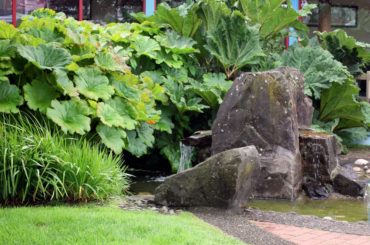
Pull on your digging boots and grab your shovel. After reading this, you are going to need more garden space.
Bigger is better, right? Maybe — yet for foliage, it depends on where the plant grows. For whatever reason plants grow humongous vegetation, they are flamboyant additions to the Northwest garden. Oversize leaves create drama — lots and lots of excitement. Surprisingly, many of them are hardy in the maritime Northwest, and many tender ones can be wintered over in a garage, greenhouse or unheated room.
There is a reason people think of tropical gardens when viewing oversize foliage. In many instances, the closer to the equator a plant grows, the larger its leaves evolved. Plants adapt to where they live, all around the globe. Think palm trees and bananas basking in the sun in the tropics, and tiny-leaf heather growing closer to the poles.
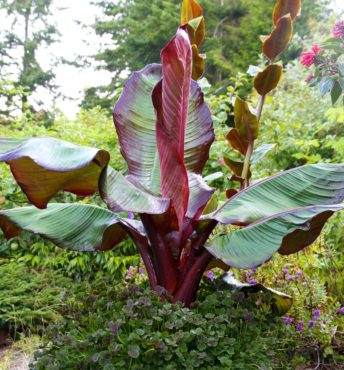
Many large-leaf plants grow in wet conditions. Even our native skunk cabbage grows the largest leaf of all the indigenous plants in our region and needs moisture to thrive.
In the shade, plants grow larger leaves, so they have more surfaces to capture more light. The downside to growing large leaves is that they evaporate more moisture. Large or small, size matters — enormous foliage in rainforests and diminutive leaves in arid conditions. The exception to the latter is plants that grow large leaves to store water, such as agave. The water-holding capabilities of their leaves are crucial for survival in an arid climate.
The rice paper plant (Tetrapanax papyrifer ‘Steroidal Giant’) is one of the hardies. It grows 10 to 20 feet tall and looks like a palm tree on steroids. The amazing, felted leaves grow to 4 feet wide.
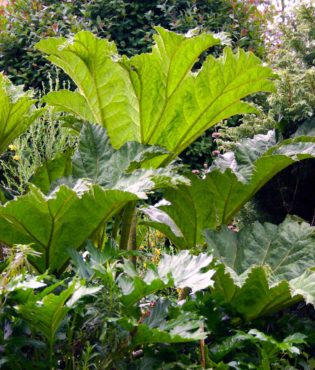
Related to Fatsia in the Aralia family, this plant typically has evergreen or semi-evergreen foliage. However, colder winters will cut it down to the ground. In response, the plant sends out runners that eventually create a Jurassic Park effect at the edge of a forest. Better yet, a colony creates a woodland jungle of its own.
Site the plant in full sun to partial shade and protect it from strong winds. It grows best with plenty of moisture during the summer drought and in humus-rich soil.
Imagine mixing a mai tai cocktail and sitting under the shade of a palm tree. Above you are 1- to 2-foot-long stems that hold 2- to 3-foot-wide, palmate, segmented leaves. Yet, you are not in the tropics. You are relaxing in your backyard.
Chances are, if you spotted a mature palm tree growing in a garden on the Kitsap Peninsula, you saw a windmill palm (Trachycarpus fortunei). This little tree is exceptionally hardy and is perfectly happy growing in this latitude west of the Cascades and farther north into British Columbia. The stems are up to 2 feet long and carry a 2- to 3-foot-wide, dark green, palmate leaf with 40 to 50 segments. The tree adapts well to most well-drained soil. The palm will reach 25 feet tall and maybe more.
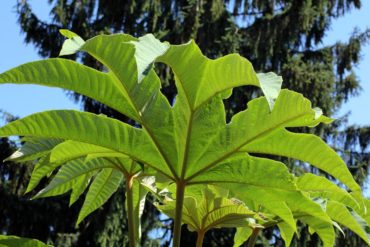
Gunnera manicata, affectionately named dinosaur food, has gigantic, orbicular foliage. A leaf from a well-grown plant can cover the length of a pro basketball player, with feet to spare. When viewing the perennial, you can almost imagine a dinosaur crashing through its giganteum leaves.
Providing Gunnera with enough ample moisture during the drought, Northwest’s mild climate helps it thrive, even though this plant is not easily grown in other regions of the country. However, it’s a moisture hog and grows best near seepages or in bogs. Yet the perennial does not like its crown wet in winter. To keep it dry, cut the large leaves in fall and lay over the crown to shed the moisture away.
Another moisture-loving, hardy perennial with large leaves (are you beginning to see a pattern?) is Astilboides tabularis. It was at one time named Rodgersia, but taxonomists split it off and put it in a genus of its own. It’s the only species recognized as an Astilboides.
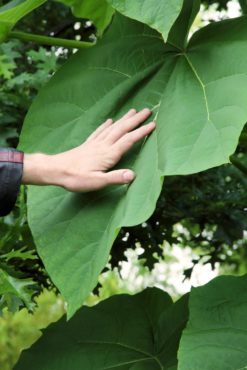
Resembling Darmera peltata foliage, Astilboides leaves are not as monstrous as the Gunnera. However, leaves that grow up to 2 feet across are impressive in their own right. The perennial is an imposing plant that grows 3 feet tall and wide.
Whatever common name one uses, all give a curtsy to its royalty — royal paulownia, empress tree or princess tree (Paulownia tomentosa). The deciduous tree is no shrinking violet. It is an extremely fast-growing tree from China.
Most gardeners grow them for the large leaves they get from coppicing or pollarding the trees every year. The added benefit of these two pruning techniques is to keep the tree more refined.
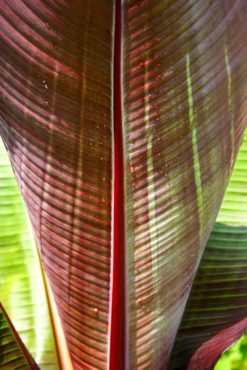
Coppicing is a pruning technique where you cut a tree or shrub nearly to the ground to renovate the shrub. Pollarding a tree is letting it grow to the size wanted and pruning it back to the trunk or main branches every year. Empress trees are great subjects for this, keeping the tree from growing too large and resulting in it developing bigger leaves. On the south side of Bond Road traveling toward Kingston and before you reach Port Gamble Road, there is an excellent example of pollarded empress trees lined up in a row along the highway.
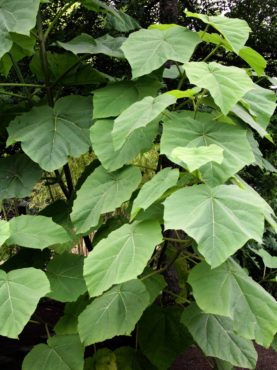
The more tender large-leaf plants make worthy container vegetation. In our region, they need to be overwintered in a greenhouse or a cool room kept above freezing.
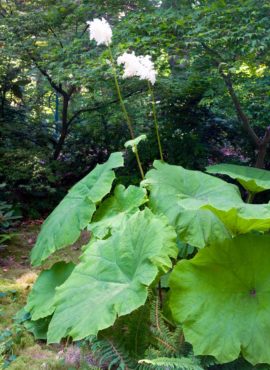
Ensete ventricosum ‘Maurelii,’ commonly called red Abyssinian banana, false banana or Ethiopian black banana, technically is not a banana plant (Musa). The glossy, paddle-shaped leaves are striking in green, maroon and red. Its thick leaves stand up better to wind than the thinner foliage of real bananas.
Originating from the mountains in East Africa, in the wild, the perennial can grow 20 feet tall. Captive in a container in our temperate climate, expect Ensete to grow up to only 10 feet in 10 years.
Rarely does this perennial flower in cultivation, yet it is a fantastic sight when it does. Unfortunately, the plant is monocarpic. Therefore, when it flowers, it dies with an astounding last hurrah in its demise.
Winter them over inside as a houseplant if you have a high enough ceiling or cut them back to about 8 inches.
It’s time to add some drama to your garden by incorporating large-leaf foliage plants. Their presence will not disappoint.






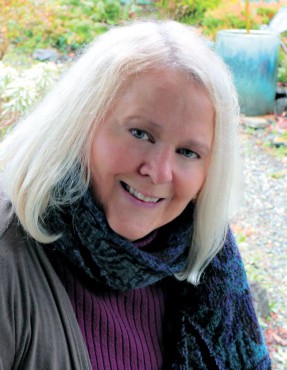


























Comments